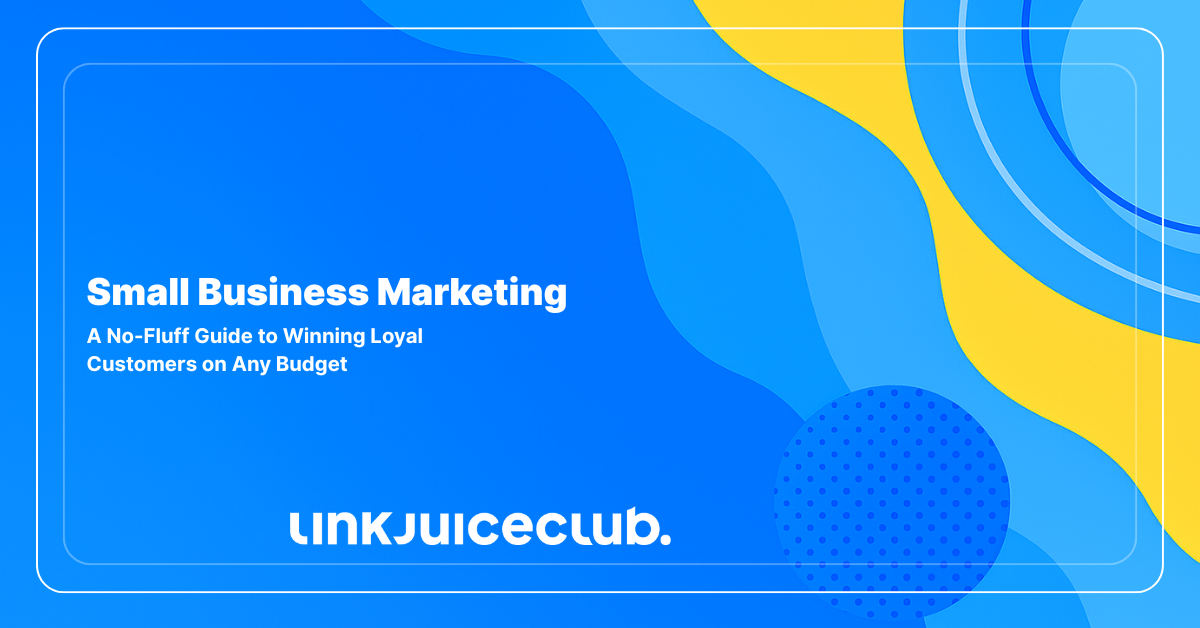
Small Business Marketing: A No-Fluff Guide to Winning Loyal Customers on Any Budget
Ever feel like you’re shouting into the void while the big brands hog all the spotlight? You’re not alone — but you’re definitely not stuck.
This isn’t just another “tips and tricks” list. This is your battle plan.
✅ Whether you’re running a cozy coffee shop or a growing e-comm side hustle…
✅ Whether you’ve got a shoestring budget or just zero time to waste…
This guide will walk you through marketing strategies that actually scale. No hacks. No hype. Just proven plays tailored for small businesses that want to grow smarter, not louder.
Let’s get your brand noticed — for all the right reasons.
What Exactly Is Small Business Marketing? (And Why You’re Probably Undervaluing It)
Building your business was the hard part — now comes the clever part: making sure the right people actually find you.

Marketing isn’t just putting your name out there. It’s creating the kind of presence that feels tailor-made for the people you serve. Because here’s the reality:
- 📊 66% of customers expect brands to understand them like a close friend — not just sell to them like a stranger.
- 🎯 That means your marketing needs to go beyond exposure. It needs to connect, convert, and keep them coming back.
Whether you’re running:
- A local shop on Main Street,
- An online store with no physical footprint, or
- A blend of both worlds…
…you need a system that brings in targeted traffic — the kind that’s already looking for what you offer.
So, what does that system look like?
It’s a mix of:
- 🔍 Organic visibility: SEO, local listings, social media presence
- 💰 Paid acceleration: PPC ads, promoted posts, influencer shoutouts
- 📬 Relationship nurturing: Email campaigns, loyalty perks, retargeting
You’re not just marketing a product — you’re building a voice, a vibe, and a value your customers can’t ignore.
Let’s unpack the steps to get your marketing machine firing on all cylinders.
Start Smart: Must-Have Tools & Tech for Small Business Marketing
No matter how lean your setup is, the right tools aren’t luxuries — they’re multipliers.
Depending on your business model, some of these will be non-negotiable, while others may just add extra horsepower. Either way, these platforms lay the foundation for smarter, faster, and more targeted marketing.
CRM: The Brain of Your Customer Strategy
Think of a Customer Relationship Management (CRM) system as your marketing HQ. It’s where all your leads, customers, conversations, and touchpoints live — organized, centralized, and ready to drive results.
With a good CRM, you can:
- 🔎 Track every interaction, from first click to final sale
- 📊 Discover patterns in behavior and buying cycles
- 🎯 Segment and personalize campaigns based on real data
In the U.S., nearly 50% of small and midsize businesses are already using CRM platforms — and 15% adopted one in just the past year. The shift is real, and it’s accelerating.
Digital Marketing Platforms: Your All-in-One Growth Engine
Digital marketing platforms aren’t just for organizing chaos — they’re command centers for scaling with precision.
Whether you’re sending emails, posting on socials, or launching promos, these tools help automate the heavy lifting while syncing seamlessly with your CRM.
Here’s how each one pulls its weight:
- 📧 Email Marketing Tools
- Create sleek campaigns without needing a designer
- Segment your audience based on behavior, interests, or buying stage
- Track open rates, clicks, and conversions with ease
✅ Perfect for nurturing leads and boosting repeat sales
- 📱 SMS Marketing Platforms
- Reach your audience where they always are — their phones
- Share time-sensitive offers, back-in-stock alerts, or limited deals
- Build high-intent micro-moments with short, snappy texts
⚡ Ideal for driving fast engagement and quick responses
- 📣 Social Media Management Suites
- Schedule posts across multiple platforms in one go
- Monitor conversations, mentions, and trending hashtags
- Analyze which content moves the needle (and which doesn’t)
📊 Use insights to fine-tune your brand voice and posting rhythm
- 🤝 Influencer Marketing Platforms
- Discover the right creators for your niche — from micro to macro
- Track campaign performance and ROI in real time
- Collaborate directly with influencers without messy spreadsheets
🎯 A smart way to tap into trust-based audiences and build buzz
These platforms aren’t optional anymore. They’re how modern small businesses compete — and win — without burning out or blowing the budget.
Reading the Room: Mastering Market Research Without Breaking the Bank
Want to make your marketing actually work? Then you need to stop guessing and start digging.
Market research isn’t about complicated reports or corporate jargon. It’s about clarity — knowing who you’re talking to, what they’re hungry for, and who else is fighting for their attention.

And here’s the good news: you don’t need a big agency budget to get the insights that matter.
What You Actually Need to Figure Out First
- Who’s your real customer? (Age, habits, problems, goals)
- What are they already spending money on?
- Who else is targeting them — and how?
- What language, channels, and triggers make them take action?
Start there, and you’ll avoid 90% of the “spray-and-pray” marketing that drains small business budgets dry.
Tools That Make the Research Easier (and Cheaper)
You don’t need to reinvent the wheel. Here’s one tool every small business should be using — because it turns raw numbers into next steps.
📈 Google Analytics: Your Website’s Behind-the-Scenes Analyst
Every visitor who lands on your site leaves a trail of digital clues — what they clicked, how long they stayed, what page made them bounce.
Google Analytics turns that chaos into clarity.
Use it to:
- See who’s visiting (location, age, device, traffic source)
- Spot your highest-performing pages and weakest links
- Track conversions and funnel drop-offs in real time
🧪 Set-up in a nutshell:
- Open a Google Analytics account
- Link your business website as a “property”
- Install the tracking tag (CMS plugins make this painless)
- Watch the data start flowing within 1–2 days
Want to level up? Pair it with Search Console or connect it to your email list for deeper intel.
Getting Ready for Small Business Marketing That Actually Converts
Before you dive headfirst into promotions and ad spends, take a beat. The real power of small business marketing lies in the prep — setting the right foundation so your efforts hit home, not just air.
This isn’t busywork. It’s the groundwork that makes your campaigns land, your content resonate, and your audience stick around.
Lock In Your Value, Audience, and Vision
Most small business owners skip this part — and that’s why most campaigns fall flat. Don’t be most businesses. Get dialed in from the jump.
💡 Define a Value Proposition That Speaks for You
Your value proposition is your brand’s heartbeat. It tells customers, “Here’s why we exist — and why we’re exactly what you’ve been looking for.”
- Focus on benefits, not just features. Show the transformation, not just the specs.
- Make it emotional. People buy when they feel understood.
- Collect real feedback from early users — then repurpose it into testimonials or case studies that reinforce your message.
🧠 Remember: 66% of business buyers want companies to offer solutions, not product pitches. Make your message about them, not you.
🎯 Know Exactly Who You’re Talking To
Effective small business marketing isn’t about casting a wide net — it’s about aiming with intent.
Drill down on your ideal customer:
- Who are they? (Age, job, lifestyle, income level)
- What problems are they trying to solve?
- What makes them choose one brand over another?
- How can your offer show up exactly when they need it?
The clearer your target, the more precise your message — and the stronger your conversions.
📏 Set Goals That Guide Every Move
Without a clear finish line, you’ll keep running in circles. That’s why every small business marketing effort needs solid, SMART goals.
- Specific: What do you want to achieve?
- Measurable: How will you know you’re winning?
- Achievable: Can you realistically hit this with your current team/tools?
- Relevant: Does this help your business grow the right way?
- Time-bound: What’s the deadline?
📊 Keep your goals visible, track your metrics regularly, and adjust as you go. Marketing is a moving target — so move with it.
Build Your Digital HQ: Launching a Website That Fuels Small Business Marketing
No, you don’t need a five-figure web designer or Silicon Valley tech skills. But if you’re serious about small business marketing, then owning your online presence isn’t optional — it’s your launchpad.
Whether you’re selling products or just want to show up when customers Google you, here’s how to create a website that actually pulls its weight.
Step 1: Lock Down Your Domain Name
Think of this as your digital address — the place people go to find you.
- Aim for your exact business name with a .com — short, clear, and easy to spell
- If it’s taken, try a .co, .net, or a smart variation that still fits your brand
- Set auto-renewal so you don’t lose your domain to someone else (yes, it happens)
Step 2: Choose a Hosting Platform That Won’t Slow You Down
This is where your website lives — and speed, reliability, and support matter more than you think.
- Most domain providers offer bundled hosting packages (keep it simple)
- Look for one-click WordPress installs or drag-and-drop builders like Wix or Squarespace
- Consider add-ons like branded email, SSL security, and daily backups
Step 3: Design with Clarity, Not Chaos
Your site doesn’t need to be fancy — it needs to work.
Here’s what to focus on:
- Use clean layouts and mobile-friendly themes (most traffic is mobile now)
- Keep colors and fonts readable — no neon-on-neon crime scenes
- Feature your business story, services, contact info, and hours front and center
- Bonus: Add a “Coming Soon” page if your full site isn’t ready yet
💡 Don’t forget ADA compliance — make sure your site’s accessible to all users. It’s not just good ethics, it’s good business.
Launching your site doesn’t have to be complicated — just intentional. A well-built website is the backbone of your small business marketing strategy. Get it right, and it becomes your hardest-working team member.
Content & SEO: The Twin Engines of Small Business Marketing
You’ve got the website. Now it’s time to get eyes on it — and not just any eyes, but the kind that are already looking for what you offer.
That’s where a smart content and SEO strategy kicks in. This duo fuels visibility, builds trust, and turns casual clicks into loyal customers — all without paying per lead.
Create Content That Actually Moves the Needle
Your website isn’t just a digital business card — it’s your most powerful marketing asset. But only if you fill it with the right content.
Start with the must-haves:
- About Us — Who you are, why you do it, and why it matters
- Services or Product Pages — Clear, benefit-driven, and SEO-optimized
- Contact Page — Make it easy to reach you with forms, email, or map embeds
- A few blog posts — Showcase expertise, answer real questions, and boost search rankings
📚 Why blog posts matter: They build topical authority and give search engines — and people — a reason to stick around.
Optimize for Search from the Start
SEO isn’t just stuffing in keywords — it’s a methodical strategy. Here’s what to focus on:
- Use high-volume, low-competition keywords tailored to your niche
- Add keywords naturally into headlines, page titles, meta descriptions, and image alt text
- Earn backlinks from reputable sites to increase domain authority
- Use internal links to keep users moving through your content
📈 Stat to know: Sites that rank #1 on Google snag nearly 30% of all clicks. Fall to #3, and that drops to 11%. The lower you rank, the less visible you are.
Promote Like You Mean It
Publishing content isn’t the finish line — it’s the starting gate.
Make noise by sharing it across:
- Social media (with platform-specific captions and visuals)
- Email newsletters
- Industry forums or groups
- Collabs with influencers or partners
Keep the message tailored to each channel, and always include a strong call to action back to your site.
The Real Toolkit: Marketing Channels That Power Small Business Growth
You don’t need to use every channel on day one — but you do need to know what’s out there.
Effective small business marketing isn’t about doing more, it’s about choosing the right mix of platforms and content types that match your audience, budget, and bandwidth.

Let’s break down the most powerful tools in your content arsenal.
Written Content That Builds Trust & Authority
Readable content is your evergreen engine — working while you sleep, sell, and scale. Here’s how each format plays its role:
- 📰 Articles
Long-form content packed with stats, expert insights, and original research. Great for building credibility and ranking in search.
✅ Use it to showcase thought leadership and industry know-how. - ✍️ Blog Posts
More conversational and product-focused. Ideal for answering questions, sharing updates, or highlighting use cases.
✅ Use it to bring in traffic and move readers down your funnel. - 📘 E-books
In-depth guides (2,000+ words) that dive deep into a topic. Often used as gated content to capture leads.
✅ Use it to generate email signups and position your brand as a go-to expert. - 📄 White Papers
Heavily researched, data-driven content targeting professionals or B2B buyers. These are serious downloads for serious buyers.
✅ Use it to nurture leads, especially in high-consideration industries. - 🎯 Landing Pages
Laser-focused pages with one job: get conversions. Whether it’s capturing emails, booking a call, or selling a product, these pages guide your visitor to a single action.
✅ Use it for campaigns, product launches, or promotions.
Online Moves That Matter: Digital Activities for Small Business Marketing
Marketing your business online isn’t just about being everywhere — it’s about showing up with intention. Each platform and tactic below isn’t just a tool… it’s a lever.
Let’s look at the digital marketing activities that drive serious results for smart, scalable small business marketing strategies.
SEO (Search Engine Optimization)
No surprise here — SEO still runs the game.
- Target what people actually search for
- Optimize pages, titles, and metadata for visibility
- Create consistent, keyword-rich content that Google loves
📌 Whether you DIY, hire a freelancer, or go full agency — just don’t skip it. SEO takes time, but it pays forever once it clicks.
Google Business Profile (Formerly Google My Business)
This free gem is your local visibility booster.
- Add your hours, photos, and contact info
- Get found in “near me” searches
- Collect and respond to customer reviews (yes, that matters)
✅ Local search visibility = foot traffic, phone calls, and conversions.
Remarketing & Retargeting
The art of the follow-up — without being annoying.
- Remarketing hits them via email (think: abandoned cart reminders)
- Retargeting shows ads to past visitors after they’ve left your site
💡 Both are cost-effective ways to recover warm leads and stay top-of-mind.
Email Marketing
Still the king of ROI — and still the most personalized channel out there.
- Segment by behavior (new, returning, loyal customers)
- Trigger messages by action (cart, page view, download)
- Provide offers, tips, and value that drives action
🔥 Use email to nurture trust, increase repeat sales, and build your own audience.
Social Media Marketing
Your front-row ticket to real-time connection and brand growth.
- Organic posts build community and trust
- Paid posts extend reach and target new users
- Platforms like Instagram, Facebook, and TikTok reward creativity and consistency
⚡ Keep the content high-value, visual, and consistent — this is where first impressions happen fast.
Influencer Marketing
Even micro-influencers (with 1K–10K followers) can drive serious niche impact.
- Choose influencers aligned with your audience and values
- Collaborate on content, giveaways, or affiliate promos
- Track engagement, not just likes
💸 Sometimes one good shoutout = more traffic than a whole ad campaign.
SEM (Search Engine Marketing)
Want to jump to the front of the line? Paid search is your shortcut.
- Use PPC (pay-per-click) ads to dominate high-intent keywords
- Ideal for launches, limited-time offers, or when SEO needs time
- Platforms like Google Ads offer instant visibility — for a price
⚖️ Balance PPC with organic SEO. Long game + short game = complete game.
Pick the channels that fit your goals, bandwidth, and budget. You don’t have to do everything — you just have to do the right things for your audience.
Who Should Handle Your Marketing? In-House, Freelancer, or Agency?
There’s no universal “best” — only what works for your goals, your time, and your budget.
Ask yourself:
- What am I trying to achieve in the next 6–12 months?
- Do I have the time and skills to execute consistently?
- What marketing tasks do I dread or delay?
- What’s my actual, working budget?
Depending on your answers, you’ll land on one of three smart paths.
Your Options at a Glance
| Option | Best For | Watch Out For |
| In-House | Owners with time, skills, and clear direction | Burnout, inconsistency, lack of expertise |
| Freelancer/Consultant | Businesses needing tactical help or SEO support | Requires clear communication and oversight |
| Agency | Scaling brands needing multi-channel execution | Higher cost, longer onboarding |
Outsourcing SEO? Choose Partners Wisely
If ranking on Google is part of your strategy (and it should be), you’ll need strong backlinks — but not the shady kind.
That’s where Link Juice Club steps in. It’s a curated link-building service designed for small business owners who want white-hat SEO wins without doing cold outreach or guest posting marathons.
No matter your path, here’s the golden rule:
🎯 Marketing without a strategy and a set budget isn’t lean — it’s lost.
Set your goals, choose your tools, and bring in help where it makes sense. That’s how small business marketing becomes sustainable — and scalable.





